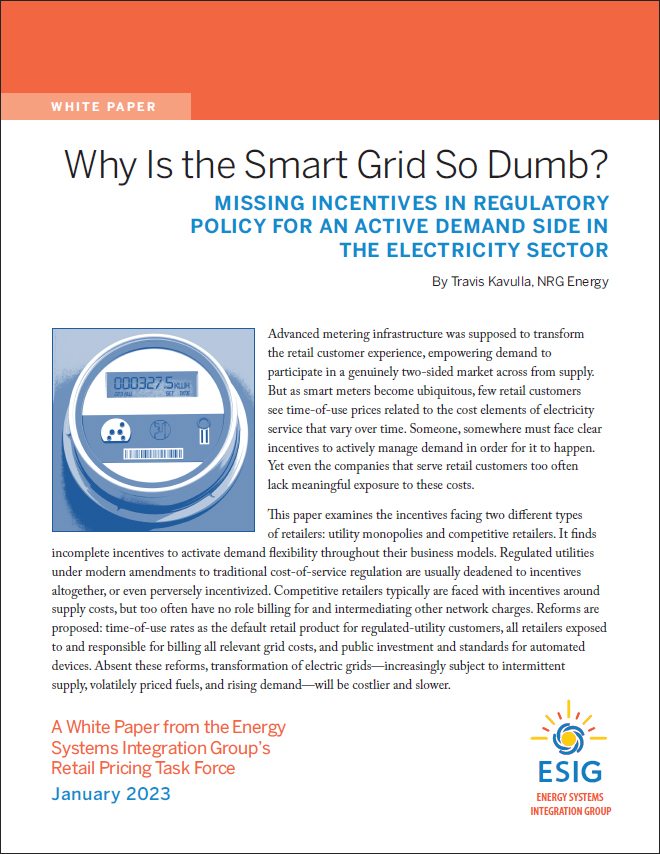 “Why Is the Smart Grid So Dumb?: Missing Incentives in Regulatory Policy for an Active Demand Side in the Electricity Sector“ is one of eight white papers from ESIG’s Aligning Retail Pricing with Grid Needs Task Force. The task force examined ways that retail pricing may be used more widely and more efficiently to allow flexible demand to respond to grid needs as the role of demand becomes increasingly important for the reliability of the grid. It brought together experts in rate design and electricity markets, transmission and distribution planning and operations, consumer advocates, and others to explore current issues, potential solutions, and practical implementation challenges involved in utilizing the flexibility in price-sensitive loads.
“Why Is the Smart Grid So Dumb?: Missing Incentives in Regulatory Policy for an Active Demand Side in the Electricity Sector“ is one of eight white papers from ESIG’s Aligning Retail Pricing with Grid Needs Task Force. The task force examined ways that retail pricing may be used more widely and more efficiently to allow flexible demand to respond to grid needs as the role of demand becomes increasingly important for the reliability of the grid. It brought together experts in rate design and electricity markets, transmission and distribution planning and operations, consumer advocates, and others to explore current issues, potential solutions, and practical implementation challenges involved in utilizing the flexibility in price-sensitive loads.
All of the white papers can be found here.
A Summary of “Why Is the Smart Grid So Dumb?: Missing Incentives in Regulatory Policy for an Active Demand Side in the Electricity Sector” by Travis Kavulla
Advanced metering infrastructure was supposed to transform the retail customer experience, empowering demand to participate in a genuinely two-sided market across from supply. But as smart meters become ubiquitous, few retail customers see time-of-use prices related to the cost elements of electricity service that vary over time. Someone, somewhere must face clear incentives to actively manage demand in order for it to happen. Yet even the companies that serve retail customers too often lack meaningful exposure to these costs.
This paper examines the incentives facing two different types of retailers: utility monopolies and competitive retailers. It finds incomplete incentives to activate demand flexibility throughout their business models. Regulated utilities under modern amendments to traditional cost-of-service regulation are usually deadened to incentives altogether, or even perversely incentivized. Competitive retailers typically are faced with incentives around supply costs, but too often have no role billing for and intermediating other network charges. Reforms are proposed: time-of-use rates as the default retail product for regulated-utility customers, all retailers exposed to and responsible for billing all relevant grid costs, and public investment and standards for automated devices. Absent these reforms, transformation of electric grids—increasingly subject to intermittent supply, volatilely priced fuels, and rising demand—will be costlier and slower.


